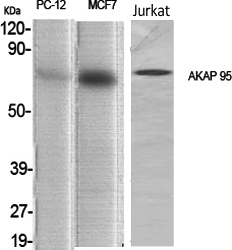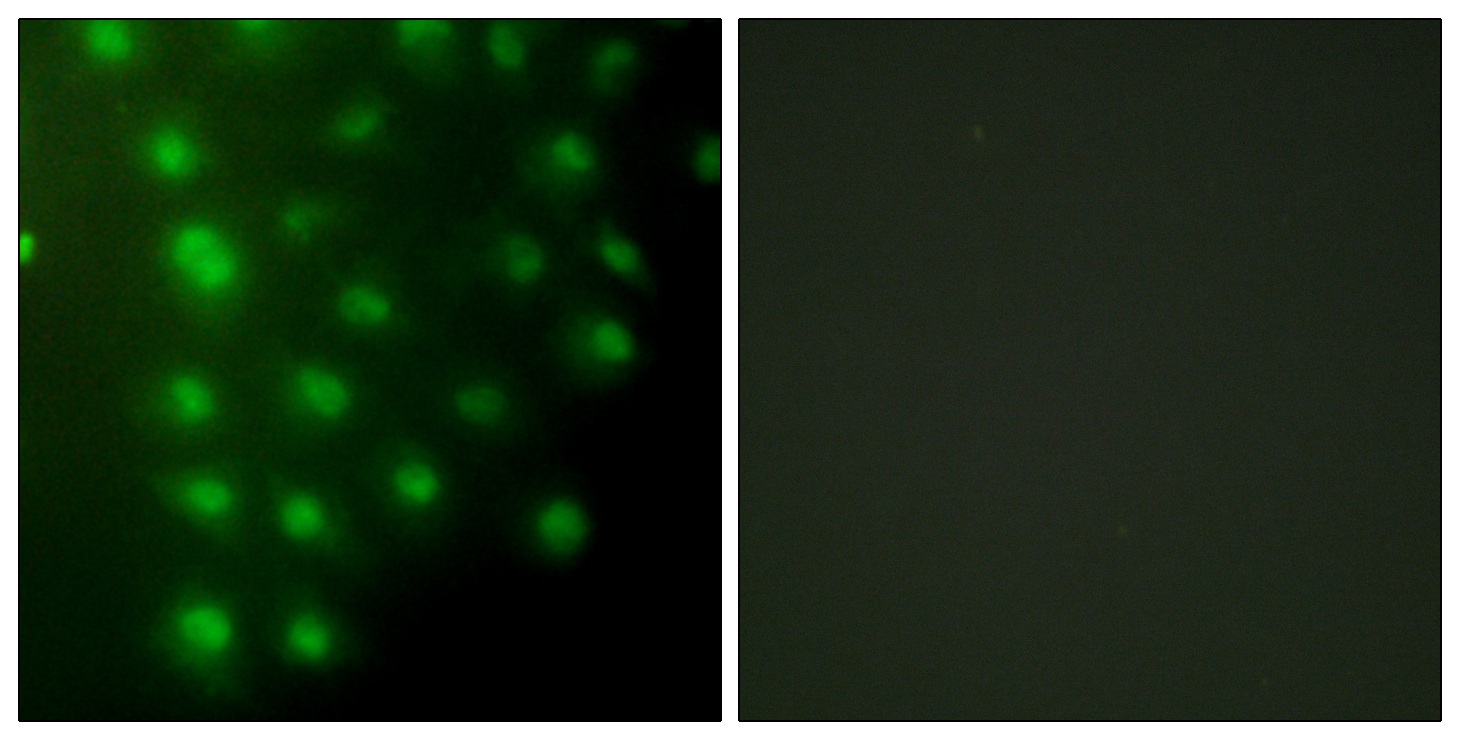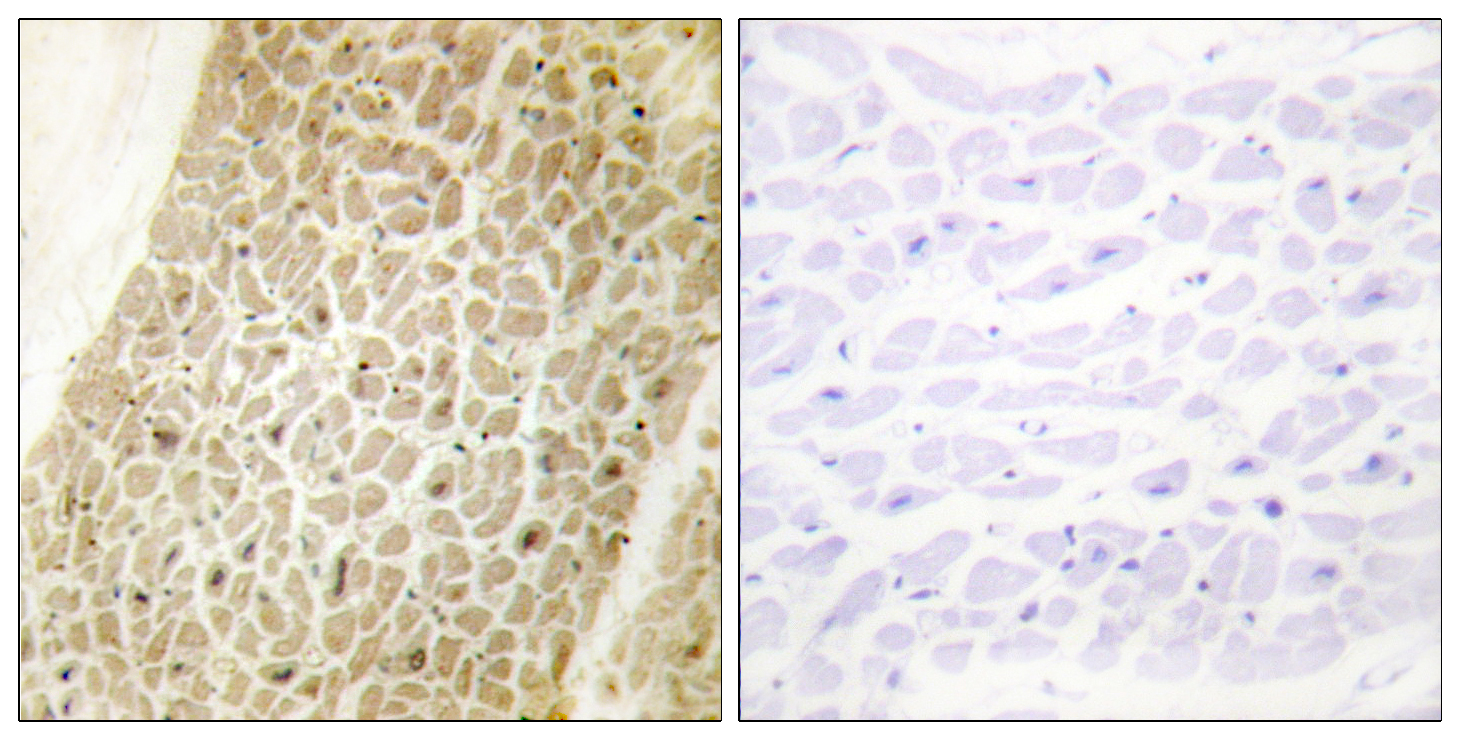AKAP 95 Polyclonal Antibody
- Catalog No.:YT0168
- Applications:WB;IHC;IF;ELISA
- Reactivity:Human;Mouse;Rat
- Target:
- AKAP 95
- Gene Name:
- AKAP8
- Protein Name:
- A-kinase anchor protein 8
- Human Gene Id:
- 10270
- Human Swiss Prot No:
- O43823
- Mouse Gene Id:
- 56399
- Mouse Swiss Prot No:
- Q9DBR0
- Rat Gene Id:
- 116633
- Rat Swiss Prot No:
- Q63014
- Immunogen:
- The antiserum was produced against synthesized peptide derived from human AKAP8. AA range:331-380
- Specificity:
- AKAP 95 Polyclonal Antibody detects endogenous levels of AKAP 95 protein.
- Formulation:
- Liquid in PBS containing 50% glycerol, 0.5% BSA and 0.02% sodium azide.
- Source:
- Polyclonal, Rabbit,IgG
- Dilution:
- WB 1:500 - 1:2000. IHC 1:100 - 1:300. IF 1:200 - 1:1000. ELISA: 1:20000. Not yet tested in other applications.
- Purification:
- The antibody was affinity-purified from rabbit antiserum by affinity-chromatography using epitope-specific immunogen.
- Concentration:
- 1 mg/ml
- Storage Stability:
- -15°C to -25°C/1 year(Do not lower than -25°C)
- Other Name:
- AKAP8;AKAP95;A-kinase anchor protein 8;AKAP-8;A-kinase anchor protein 95 kDa;AKAP 95
- Observed Band(KD):
- 76kD
- Background:
- This gene encodes a member of the A-kinase anchor protein family. A-kinase anchor proteins are scaffold proteins that contain a binding domain for the RI/RII subunit of protein kinase A (PKA) and recruit PKA and other signaling molecules to specific subcellular locations. This gene encodes a nuclear A-kinase anchor protein that binds to the RII alpha subunit of PKA and may play a role in chromosome condensation during mitosis by targeting PKA and the condensin complex to chromatin. A pseudogene of this gene is located on the short arm of chromosome 9. [provided by RefSeq, May 2011],
- Function:
- function:Anchoring protein that mediates the subcellular compartmentation of cAMP-dependent protein kinase (PKA type II).,similarity:Belongs to the AKAP95 family.,subcellular location:Associated with the nuclear matrix. Redistributed and detached from condensed chromatin during mitosis.,subunit:Binds to dimeric RII-alpha regulatory subunit of PKA during mitosis.,tissue specificity:Highly expressed in heart, liver, skeletal muscle, kidney and pancreas.,
- Subcellular Location:
- Nucleus . Nucleus matrix . Nucleus, nucleolus . Cytoplasm . Associated with the nuclear matrix in interphase and redistributes mostly to chromatin at mitosis. However, mitotic chromatin localization has been questioned. Upon nuclear reassembly at the end of mitosis, is sequestered into the daughter nuclei where it re-acquires an interphase distribution. Exhibits partial localization to the nucleolus in interphase, where it colocalizes with UBTF/UBF, suggesting localization to the fibrillary center and/or to the dense fibrillary component. Colocalizes with GJA1 at the nuclear membrane specifically during cell cycle G1/S phase. .
- Expression:
- Highly expressed in heart, liver, skeletal muscle, kidney and pancreas. Expressed in mature dendritic cells.
- June 19-2018
- WESTERN IMMUNOBLOTTING PROTOCOL
- June 19-2018
- IMMUNOHISTOCHEMISTRY-PARAFFIN PROTOCOL
- June 19-2018
- IMMUNOFLUORESCENCE PROTOCOL
- September 08-2020
- FLOW-CYTOMEYRT-PROTOCOL
- May 20-2022
- Cell-Based ELISA│解您多样本WB检测之困扰
- July 13-2018
- CELL-BASED-ELISA-PROTOCOL-FOR-ACETYL-PROTEIN
- July 13-2018
- CELL-BASED-ELISA-PROTOCOL-FOR-PHOSPHO-PROTEIN
- July 13-2018
- Antibody-FAQs
- Products Images

- Western Blot analysis of various cells using AKAP 95 Polyclonal Antibody diluted at 1:1000 cells nucleus extracted by Minute TM Cytoplasmic and Nuclear Fractionation kit (SC-003,Inventbiotech,MN,USA).
.jpg)
- Western Blot analysis of MCF7 cells using AKAP 95 Polyclonal Antibody diluted at 1:1000 cells nucleus extracted by Minute TM Cytoplasmic and Nuclear Fractionation kit (SC-003,Inventbiotech,MN,USA).

- Immunofluorescence analysis of HUVEC cells, using AKAP8 Antibody. The picture on the right is blocked with the synthesized peptide.

- Immunohistochemistry analysis of paraffin-embedded human heart tissue, using AKAP8 Antibody. The picture on the right is blocked with the synthesized peptide.

- Western blot analysis of lysates from mouse heart and Jurkat cells, using AKAP8 Antibody. The lane on the right is blocked with the synthesized peptide.



